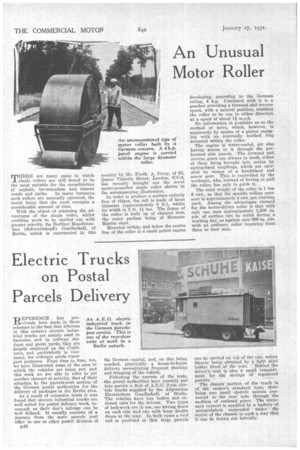An Unusual Motor Roller
Page 66

If you've noticed an error in this article please click here to report it so we can fix it.
TIIERE are many cases in which single rollers are still found to be the most suitable for the consolidation of asphalt, tar-macadam and cement roads and paths. In many instances such rollers are inanually operated, the result being that the work occupies a considerable amount of time.
With the object of retaining the advantages of the single roller, whilst enabling work to be carried out with greater celerity, the Berliner Maschinenban (SchwartzkopfC) Gesellschaft, of Berlin, 'which is represented in this country by Mr. Fredk. A. Perry, of 6.3, Queen Victoria Street, London, E.C.4, has recently brought out the novel motor-propelled single roller shown in the accompanying illustration. In order to produce a surface entirely free of ridges, the roll is made of large diameter (approximately 5 ft.), whilst its width is 2 ft. I ins. The frame of the roller is built up of channel iron, the outer surface being of SiemensMartin steel.
Mounted within, and below the centre line of the roller is a small petrol engine developing, according to the German rating, 4 h.p. Combined with it is a gearbox providing a forward and reverse speed, with a neutral position, enabling the roller to be run in either direction at a speed of about 11 m.p.h.
No information is available as to the method of drive, which, however, is apparently by means of a pinion engaging with an internally toothed ring mounted within the roller.
The engine is water-cooled, air also having access to it through the perforated side panels. The forward and reverse gears are always in mesh, either of them being brought into action by spring-band couplings, which are operated by means of a handwheel and screw gear. This is controlled by the workman, who, instead of having to pull the roller, has only to guide it.
The total weight of the roller is 1 ton 8 cwt., so that the specific rolling pressure is approximately 4 cwt. per running yard. Among the advantages claimed for the motor-driven roller is that with only one man approximately 1,200 sq. yds. of surface can be rolled during a working day, as against only 600 sq. yds. with an ordinary roller requiring from three to four men.




































































































